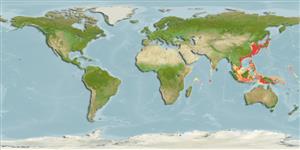Elasmobranchii (tubarões e raias) (sharks and rays) >
Carcharhiniformes (Ground sharks) >
Triakidae (Houndsharks) > Triakinae
Etymology: Mustelus: Latin for weasel, an ancient name for sharks, possibly referring to the pointed snouts, swift movements and/or rapacious feeding behavior of smaller predatory sharks [strictly not tautonymous with Squalus mustelus Linnaeus 1758 since type was designated by the ICZN]. (See ETYFish); manazo: Japanese vernacular for this shark. (See ETYFish).
More on author: Bleeker.
Environment: milieu / climate zone / depth range / distribution range
Ecologia
marinhas demersal; intervalo de profundidade 0 - 360 m (Ref. 13563). Tropical; 45°N - 10°S
Western Indian Ocean: Kenya. Western Pacific: southern Siberia, Japan, Korea, China, Taiwan and Viet Nam; Chesterfield Islands (Ref. 11897).
Length at first maturity / Tamanho / Peso / Idade
Maturity: Lm 65.0, range 62 - 68 cm
Max length : 220 cm TL macho/indeterminado; (Ref. 4883); peso máx. Publicado: 5.7 kg (Ref. 40637); Idade máx. registada: 10 anos (Ref. 6081)
Found in the intertidal zone, on mud and sand bottom, down to a depth of at least 360 m (Ref. 13563). May also be found in semi-enclosed sea areas (Ref. 11230). Feeds mainly on bottom invertebrates, also bony fishes (Ref. 244). Ovoviviparous (Ref. 50449). Caught regularly by demersal longliners operating both inshore and in deep-water (Ref.58048). Utilized for human consumption (Ref. 244).
Ovoviviparous, embryos feed solely on yolk (Ref. 50449), with 1 to 22 (Ref.58048 reports 5-14)young in a litter. Gestation period takes about 10 months (Ref. 244) or 11-12 months (Ref. 28055). Young born in spring. Distinct pairing with embrace (Ref. 205).
Compagno, L.J.V., 1984. FAO Species Catalogue. Vol. 4. Sharks of the world. An annotated and illustrated catalogue of shark species known to date. Part 2 - Carcharhiniformes. FAO Fish. Synop. 125(4/2):251-655. Rome: FAO. (Ref. 244)
Categoria na Lista Vermelha da IUCN (Ref. 130435)
Ameaça para o homem
Harmless
Utilização humana
Pescarias: espécies comerciais; peixe desportivo: sim
Mais informação
ColaboradoresFotografiasStamps, Coins Misc.SonsCiguateraVelocidadeTipo de nataçãoÁrea branquialOutras referênciasCérebrosVisão
Ferramentas
Relatórios especiais
Descarregue XML
Fontes da internet
Estimates based on models
Preferred temperature (Ref.
123201): 14.4 - 28.1, mean 23.2 °C (based on 677 cells).
Phylogenetic diversity index (Ref.
82804): PD
50 = 0.5000 [Uniqueness, from 0.5 = low to 2.0 = high].
Bayesian length-weight: a=0.00214 (0.00117 - 0.00391), b=3.13 (2.97 - 3.29), in cm total length, based on LWR estimates for this species & Genus-body shape (Ref.
93245).
Nível Trófico (Ref.
69278): 3.7 ±0.1 se; based on diet studies.
Resiliência (Ref.
120179): Muito baixo, tempo mínimo de duplicação da população maior que 14 anos (K=0.07; tm=1.9-4; tmax=10; Fec=1).
Fishing Vulnerability (Ref.
59153): High vulnerability (63 of 100).
Nutrients (Ref.
124155): Calcium = 17.6 [5.5, 90.4] mg/100g; Iron = 0.424 [0.128, 1.518] mg/100g; Protein = 21.1 [18.7, 23.4] %; Omega3 = 0.0841 [, ] g/100g; Selenium = 116 [33, 429] μg/100g; VitaminA = 7.92 [2.91, 21.89] μg/100g; Zinc = 0.767 [0.337, 1.566] mg/100g (wet weight);
